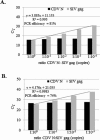Development of a duplex real-time RT-qPCR assay to monitor genome replication, gene expression and gene insert stability during in vivo replication of a prototype live attenuated canine distemper virus vector encoding SIV gag
- PMID: 25486083
- PMCID: PMC7111484
- DOI: 10.1016/j.jviromet.2014.11.015
Development of a duplex real-time RT-qPCR assay to monitor genome replication, gene expression and gene insert stability during in vivo replication of a prototype live attenuated canine distemper virus vector encoding SIV gag
Abstract
Advancement of new vaccines based on live viral vectors requires sensitive assays to analyze in vivo replication, gene expression and genetic stability. In this study, attenuated canine distemper virus (CDV) was used as a vaccine delivery vector and duplex 2-step quantitative real-time RT-PCR (RT-qPCR) assays specific for genomic RNA (gRNA) or mRNA have been developed that concurrently quantify coding sequences for the CDV nucleocapsid protein (N) and a foreign vaccine antigen (SIV Gag). These amplicons, which had detection limits of about 10 copies per PCR reaction, were used to show that abdominal cavity lymphoid tissues were a primary site of CDV vector replication in infected ferrets, and importantly, CDV gRNA or mRNA was undetectable in brain tissue. In addition, the gRNA duplex assay was adapted for monitoring foreign gene insert genetic stability during in vivo replication by analyzing the ratio of CDV N and SIV gag genomic RNA copies over the course of vector infection. This measurement was found to be a sensitive probe for assessing the in vivo genetic stability of the foreign gene insert.
Keywords: Canine distemper virus vaccine vector; Duplex real-time qPCR; Ferrets; SIV gag.
Copyright © 2014 Elsevier B.V. All rights reserved.
Figures

 ) and probe (
) and probe ( ) for the Gag specific gRNA RT-qPCR assay and the 1500–1669 Nt indicates the amplicon and the binding site for qPCR forward primer (
) for the Gag specific gRNA RT-qPCR assay and the 1500–1669 Nt indicates the amplicon and the binding site for qPCR forward primer ( ) and probe (
) and probe ( ) used in the Gag specific mRNA RT-qPCR assay.
) used in the Gag specific mRNA RT-qPCR assay.





Similar articles
-
Membrane-bound SIV envelope trimers are immunogenic in ferrets after intranasal vaccination with a replication-competent canine distemper virus vector.Virology. 2013 Nov;446(1-2):25-36. doi: 10.1016/j.virol.2013.07.012. Epub 2013 Aug 9. Virology. 2013. PMID: 24074564
-
Real-time reverse transcription polymerase chain reaction method for detection of Canine distemper virus modified live vaccine shedding for differentiation from infection with wild-type strains.J Vet Diagn Invest. 2014 Jan;26(1):27-34. doi: 10.1177/1040638713517232. J Vet Diagn Invest. 2014. PMID: 24532693
-
Quantitative multiplex assay for simultaneous detection of the Indiana serotype of vesicular stomatitis virus and HIV gag.J Virol Methods. 2007 Jul;143(1):55-64. doi: 10.1016/j.jviromet.2007.02.007. Epub 2007 Mar 26. J Virol Methods. 2007. PMID: 17382412
-
Rapid and sensitive detection of canine distemper virus by real-time reverse transcription recombinase polymerase amplification.BMC Vet Res. 2017 Aug 15;13(1):241. doi: 10.1186/s12917-017-1180-7. BMC Vet Res. 2017. PMID: 28810858 Free PMC article.
-
Biological properties of phocine distemper virus and canine distemper virus.APMIS Suppl. 1993;36:1-51. APMIS Suppl. 1993. PMID: 8268007 Review.
Cited by
-
A fast and simple one-step duplex PCR assay for canine distemper virus (CDV) and canine coronavirus (CCoV) detection.Arch Virol. 2018 Dec;163(12):3345-3349. doi: 10.1007/s00705-018-3982-8. Epub 2018 Aug 23. Arch Virol. 2018. PMID: 30141131 Free PMC article.
-
Establishment of reverse transcription loop-mediated isothermal amplification for rapid detection and differentiation of canine distemper virus infected and vaccinated animals.Infect Genet Evol. 2015 Jun;32:102-6. doi: 10.1016/j.meegid.2015.03.002. Epub 2015 Mar 10. Infect Genet Evol. 2015. PMID: 25769803 Free PMC article.
References
-
- Appel M.J.G. Elsevier Science; Distributors for the U. S. and Canada Elsevier Science Pub. Co; Amsterdam; New York, NY: 1987. Virus Infections of Carnivores.
-
- Barrera J.C., Letchworth G.J. Persistence of vesicular stomatitis virus New Jersey RNA in convalescent hamsters. Virology. 1996;219:453–464. - PubMed
-
- Brandler S., Lucas-Hourani M., Moris A., Frenkiel M.P., Combredet C., Fevrier M., Bedouelle H., Schwartz O., Despres P., Tangy F. Pediatric measles vaccine expressing a dengue antigen induces durable serotype-specific neutralizing antibodies to dengue virus. PLoS Negl. Trop. Dis. 2007;1:e96. - PMC - PubMed
Publication types
MeSH terms
Substances
LinkOut - more resources
Full Text Sources
Other Literature Sources

